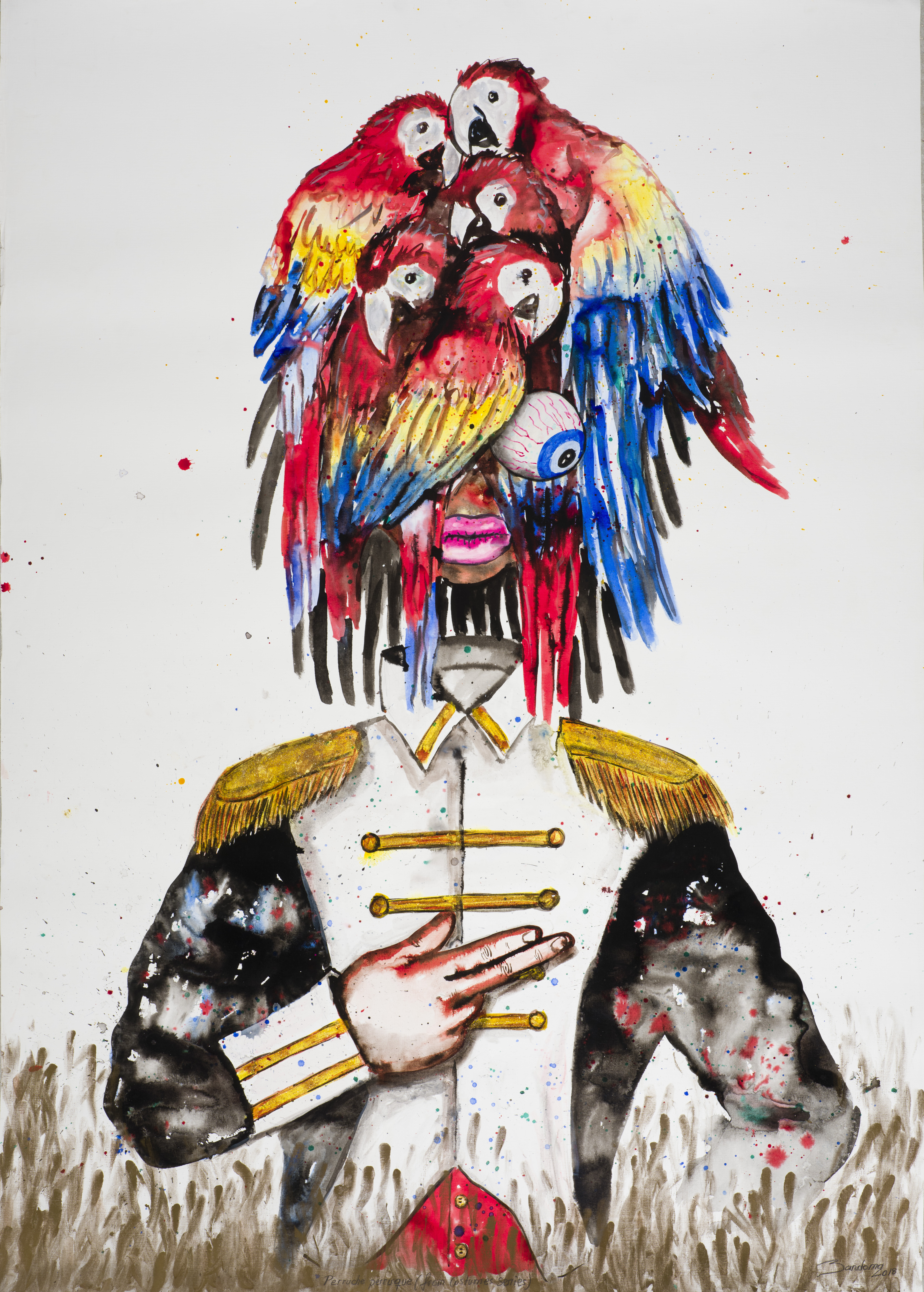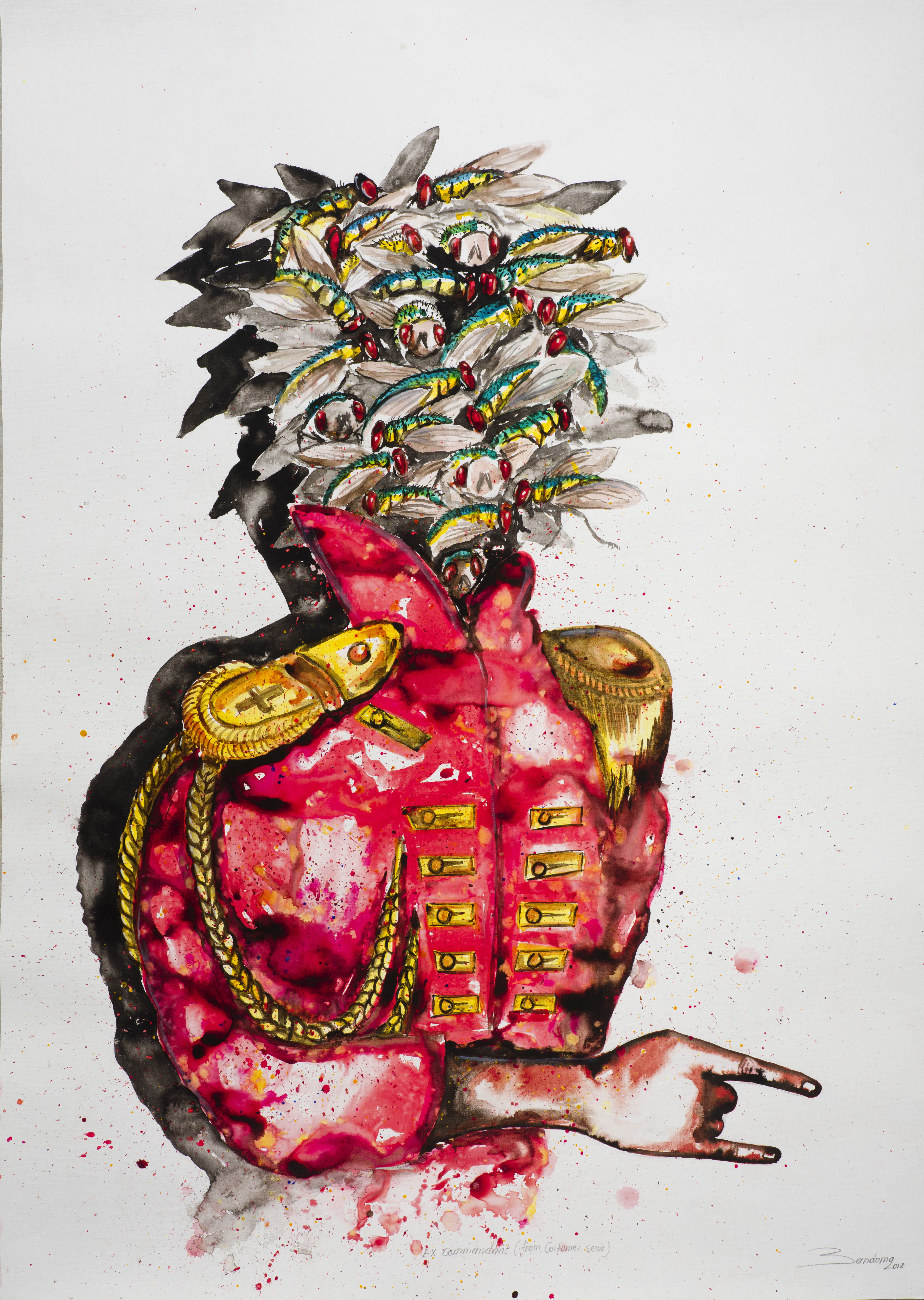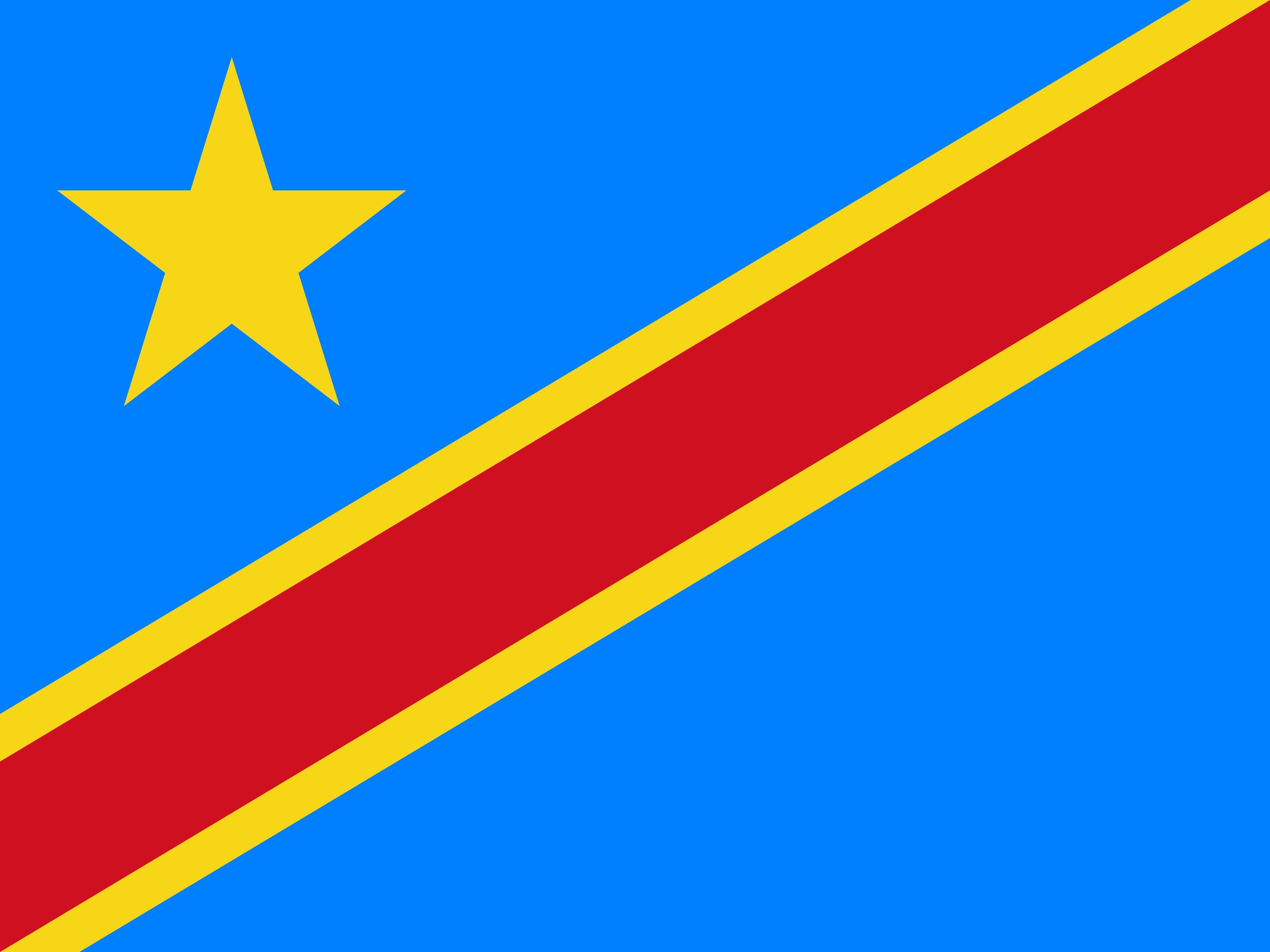Steve Bandoma (Congolese, b. 1981)
War, like any political order, is a constructed thing. It’s human. No natural law commands it, and there’s nothing about it that’s immutable or permanent. Conflict isn’t wired into the organs or the bones, and there is a covert bigotry to the idea that war is the only possible destiny for certain people in certain places, or to the notion that there are societies incapable of breaking out of their own deadly logic of conflict. However enormous it may seem, the conflict in DRC is as inevitable as any other. There is nothing inevitable about it.
–Armin Rosen1
The Democratic Republic of the Congo (DRC) is nearly synonymous in the Western imagination with governmental corruption and human rights violations because it was constructed in this way by the West. The history of the country contains so many compacted traumas that it is difficult to comprehend from a distance, much less to live through. This is what Steve Bandoma is addressing in his body of work. While there is a long history of empire in the region that would become the DRC—including those of the Kongo kingdom, which began in the fourteenth century, and the sixteenth-century Kuba kingdom—there was an amplification of the exploitation of human and natural resources beginning with King Leopold’s Congo Free State regime, which lasted from 1885 until he was forced to relinquish it to the Belgian government in 1908, when it became the Belgian Congo. It is arguable whether conditions improved at that point, as commercial interests were prioritized along with missionary and state interests. In 1960, the Republic of Congo became independent from Belgium and the period of internal strife known as the Congo crisis began, ending with Mobutu Sese Seko seizing control with the help of American and Belgian forces. This was, in part, a subsidiary process of the Cold War: in 1960 Prime Minister Patrice Lumumba called on the Soviet Union to send reinforcements against the rebels, although he was captured at the end of the year and executed at Mobutu’s behest in early 1961.2
When Mobutu took formal control of the government in 1965, he renamed the country Zaire, part of a larger authenticity initiative that included renaming cities known by colonial monikers (Léopoldville, for example, became Kinshasa), and instituted rules and programs, as diplomat and policy analyst Kenneth Adelman states, to “stop the mental alienation brought by the colonial experience.”3 Western support for Mobutu was largely prompted by his opposition to communism (though he was actually anti-USSR, rather than anti-communist), but largely overlooked his government’s human rights violations and the economic devastation and hyperinflation that occurred while Mobutu personally accumulated wealth by exploiting the country’s population and resources, just as his colonial predecessors had. In 1997, a coup left Mobutu out of power and exiled, but the country, now the Democratic Republic of the Congo, was left deep in further civil war. This was followed by another civil war, the Congo Second War, which included numerous rebel militias and international involvement. The devastation is incalculable, predominantly due to disease, famine, displacement, and the conscription of Kadogos, or child soldiers. It has also left in its wake smaller, regional conflicts, and continued environmental crises caused by mining, poaching, and deforestation.
This potted 150-year history of turmoil excludes the rich artistic and cultural traditions of a deeply diverse country. For example, the Sapeurs (or La Sape) and Catch Fétiche have become popular icons of Congolese culture, and Bandoma combines this brightly colored and dramatic aesthetic lexicon with the country’s complex political history to explore corruption, international meddling, and the visual vernacular of power. There is a grotesqueness to Bandoma’s drawings—a bulging, bloodshot eye here and flesh with burns and wounds there, blurring the line between perpetrator and victim. While some of the monsters in this exhibition point to serious issues in a detached, ironic way, Bandoma’s do not have that privilege. Speaking of his series Camouflage (2020), Bandoma describes the DRC as “this country that could be a haven of peace for future humanity, is nothing but a vaguely disguised war-zone.”4 This is not the result of one leader who held onto power and terrorized their citizens. Journalist Armin Rosen probes more deeply than the matter of who is in power at any given time when he describes the ongoing conflict in the eastern DRC: “violence isn’t a means to a higher end in DRC, but the expression of a deeper social, political and historical rot. Here, it’s possible to witness how war can become systemic and normal, even in the absence of some broader, national-level struggle — how a region can become trapped in violent tension and mistrust.”5 Bandoma addresses this rot head-on in his work, where European military garb, synonymous with power and derived from the Belgian imperial legacy, is desecrated with a business of flies or a flock of birds replacing the analytical center of the human body—the head. This seeming defilement of authority is mimicked by reality: in the northeast corner of the DRC, the epicenter of unrest, the difference between official military, rebel factions, and common criminals is negligible: “they all wear the same standard-issue, dark-green military uniforms. Some have shoulder patches depicting the Congolese flag. Others don’t. The difference between the patch-wearers and non patch-wearers is technical and meaningless.”6 Evoking this chaos, Bandoma’s Ex Commandant suffers from a swarm of blowflies consuming its head. Attracted to rotting flesh, where the flies lay their eggs, the insects project a shadow of wild hair. The figure’s arm crosses its body with pinky and forefinger outstretched, mimicking a military hand gesture, even as it is being consumed.
This cycle of occupation and strife is owed to the natural ecology of the DRC, whose rubber trees and elephant ivory comprised Leopold’s stake in the industrial era, and whose raw materials continue to propel violence today. Rich in fossil energy and metal, “just feet beneath the surface of the earth are enough minerals to keep the global technology and defense industries humming,” where mining is often undertaken to the financial advantage of the rebel factions.7 To this end, where natural resources are not directly owned by European companies, their financial benefit trickles down to militia groups rather than citizens. While civil war ravages the eastern border, 1,000 miles west in the capital of Kinshasa, culture thrives and safety is no concern, but political corruption and the theatrics of power prosper.
It is at this intersection that Bandoma’s work is situated. Within the borders of the DRC there are more than 250 ethnic groups and 700 languages spoken. But within the colonial borders, demonstrations of power incorporate pan-African symbols with Western military costume and international corporate branding. Bandoma’s drawing of a military leader in Western uniform with gold epaulettes, a trope of power and authority, is crowned with a perruche perruque, a “parakeet wig.” The creature is only human in form, with a pandemonium of parrots forming its overly large head, one human eye bulging out from the tangle of their wings. It is easy to imagine their wings flapping, a riot of squawks, and the mess they leave below their perch. The diverse ecology is disrupted in two ways: the first is through the mining and exporting of the natural resources; the second is importing flora and fauna that are not indigenous to the region. There are a variety of parrots native to central Africa, and although the scarlet macaw is not one of them, the blue, red, and yellow of its feathers are the colors of the DRC’s national flag, adopted in 2006 and symbolizing peace, bloodshed, and the wealth of the country, with a star representing hope against the blue field at upper-left. Even if Bandoma’s evocation of the DRC flag is inadvertent, his incorporation of the nonindigeonous parrot points to the way that globalization upsets ecology: beautiful species have long been captured and shipped across oceans, or upon a camel across the desert. When a bird is not destined to a life in captivity, a symbol of the owner’s wealth, it risks disrupting an ecosystem that was not prepared for its arrival.8
But the bird is a useful metaphor either way: scarlet macaws behave similarly to their central African relative, the grey parakeet, in that they mimic sounds. In the DRC, government transitions are infrequent, the most recent occurring in 2019 when Félix Tshisekedi was elected, ending the nearly two-decade tenure of Joseph Kabila (whose father helped overthrow Mobutu in 1997 and became president until his own assassination in 2001, days before his son rose to power), each running on a platform of peace and prosperity and mimicking the destruction and exploitation of their predecessor and their images of power. The monsters created by Bandoma poke at this reality: the DRC is wealthy, and the people of the DRC are poor. Its citizens are the byproduct of an economic and political process that is destructive ecologically and to human rights, to such an extreme that the land and people of the DRC are now both mere resources, their histories and futures futilely intertwined.
Notes
-
Armin Rosen, “The Origins of War in the DRC,” The Atlantic, June 26, 2013, https://www.theatlantic.com/international/archive/2013/06/the-origins-of-war-in-the-drc/277131. ↩︎
-
Less than two months after Lumumba’s arrest in November 1960, Mobutu sent him to Katanga—a region that seceded from the Republic of Congo twelve days after independence—where the Belgian-backed governor there, Moise Tshombe, executed him. Lumumba was an enemy in the region and Mobutu knew this, so he knew that if he sent Lumumba there, he would not return. See Paul Kenyon, Dictatorland: The Men Who Stole Africa. London: Head of Zeus, 2018, 3-62. ↩︎
-
Kenneth Lee Adelman, “Recourse to Authenticity and Negritude in Zaire,” The Journal of Modern African Studies 13, no. 1 (1975): 134. Although this is an older article, it was published shortly after the movement of Authenticity or Mobutism was formally instituted, so it is particularly useful in understanding the sentiments around and reaction to the shift away from pan-Africanism and Negritude in this context. Adelman wrote his dissertation on religion in Zaire in 1975 and held a variety of bureaucratic posts in the last five decades. ↩︎
-
Steve Bandoma, “Artist statement,” Sulger Buel Gallery, accessed May 3, 2021, https://www.sulger-buel-gallery.com/exhibitions/19/works/artworks-625-steve-bandoma-jeu-kizengi-2018. ↩︎
-
Rosen, “The Origins of War in the DRC.” ↩︎
-
Rosen, “The Origins of War in the DRC.” ↩︎
-
Rosen, “The Origins of War in the DRC.” ↩︎
-
A recent article by Rebecca Mead considers the history of importing exotic species and including them in art to demonstrate the wealth and reach of the patron. Rebecca Mead, “Invasive Species,” New Yorker, July 5, 2021, 20-24. ↩︎


